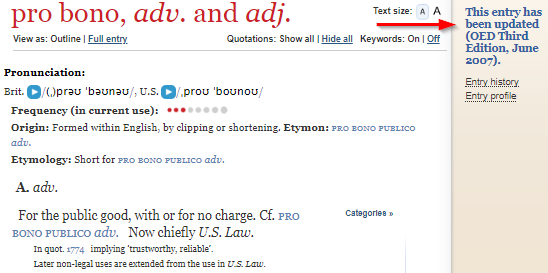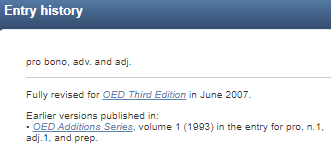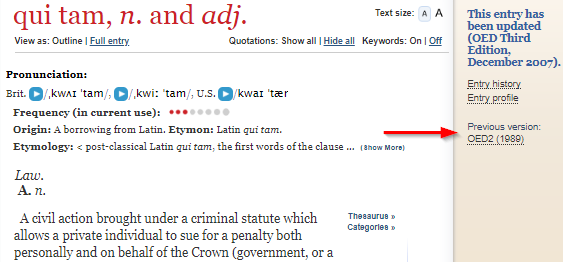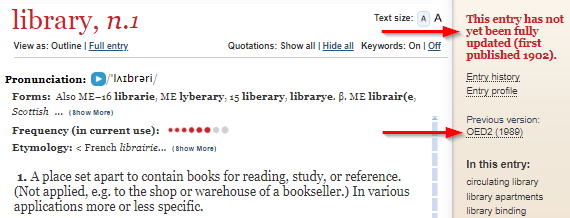Blog
Understanding the Editions of the Oxford English Dictionary, Part 2
On Tuesday we explored the history of the Oxford English Dictionary from its 1857 origins to the publication of the Second Edition in 1989. Though the Second Edition is the last edition available in print, the OED is continuously being updated on its online platform. In fact, not only are new words added to the OED, each existing word is individually being evaluated and updated as part of the Third Edition. Let's explore how the current updating process works and how to find out if an individual word has been updated.
The updating process to the Second Edition began in 1993 and continues today. The revision process begins with the collection of evidence. This evidence comes from numerous sources, including "targeted reading programmes" where readers "scrutinize texts such as novels, poetry, magazines, newspapers, scientific journals, television scripts, etc." looking for "examples of new words, but also for good, quotable examples of older words". Historical dictionaries, online databases, and public contributions also add to the evidence for revision.
Once evidence has been gathered, the quotations need to be organized. Editors and research assistants use the OED's "quotation-card collection" to "assess the frequency of occurrence and meaning of potential new entries". From this research the decision to include or not include a word or meaning is made. The OED does not include every word. For example, if the editors could only find one example of a word, it may not meet the criteria to be included in the OED. However, the example is kept in the quotation-card collection in case further examples eventually surface.
After a word or meaning has been chosen for inclusion in the OED, the editing process begins. There are five principal components to each OED entry: spelling, etymology, pronunciation, illustrative quotations, and definition(s). Once these are in place, the editor will evaluate the entry as a whole "to ensure that the various parts satisfactorily demonstrate the term’s history and development in English". When needed, specialists, like etymological editors, may be consulted. Bibliographical editors also double check the citations, ensuring that the "the text and date of evidence are as accurate as possible".
But what does this lengthy, time-consuming update process mean for the end-user? It means that the edition of the OED on the online database depends on the word. Some words haven't been revised yet and the Second Edition is the most up-to-date version of the word. Some words have been revised but not fully updated, so the online edition may differ from the print Second Edition. And some words have been fully updated and are considered part of the Third Edition.
Each entry in the OED online lists its history. Pro bono, for example, was updated for the Third Edition in the June 2007 update:

Clicking on "Entry history" shows that this phrase was added to the OED as part of the 1993 Addition, after the publication of the Second Edition:

For updated Third Edition entries that were included in the Second Edition, a link to the Second Edition text is included in the Third Edition entry. As an example, see the entry for qui tam:

The OED revision project is on-going, and not all entries have been updated. The entry for library, for example, has not been fully updated. However, you can compare its current iteration with its entry in the Second Edition:

The OED online is updated on a quarterly basis, and the lists of updates are available online. The October 2019 update added over 650 new words, senses, and subentries, including easy-breezy, promposal, and whatevs. Star Wars even made it into the OED with entries for lightsaber, Jedi, and Padawan.
For more information on the OED revision process, see Rewriting the OED, Collecting the evidence, Sorting of quotations, Editing of entries, Researching the language, and Bibliographical standardization.




